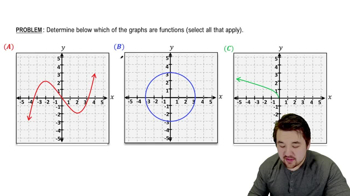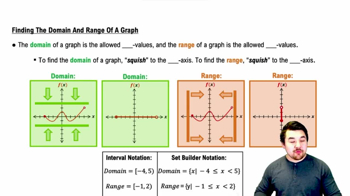Table of contents
- 0. Functions7h 52m
- Introduction to Functions16m
- Piecewise Functions10m
- Properties of Functions9m
- Common Functions1h 8m
- Transformations5m
- Combining Functions27m
- Exponent rules32m
- Exponential Functions28m
- Logarithmic Functions24m
- Properties of Logarithms34m
- Exponential & Logarithmic Equations35m
- Introduction to Trigonometric Functions38m
- Graphs of Trigonometric Functions44m
- Trigonometric Identities47m
- Inverse Trigonometric Functions48m
- 1. Limits and Continuity2h 2m
- 2. Intro to Derivatives1h 33m
- 3. Techniques of Differentiation3h 18m
- 4. Applications of Derivatives2h 38m
- 5. Graphical Applications of Derivatives6h 2m
- 6. Derivatives of Inverse, Exponential, & Logarithmic Functions2h 37m
- 7. Antiderivatives & Indefinite Integrals1h 26m
- 8. Definite Integrals3h 25m
0. Functions
Introduction to Functions
Problem 41c
Textbook Question
Velocity from position The graph of represents the position of an object moving along a line at time . <IMAGE>
c. Sketch a graph of the velocity function.
 Verified step by step guidance
Verified step by step guidance1
Identify the position function s = f(t) from the graph provided, noting key features such as intercepts, maxima, minima, and points of inflection.
Determine the velocity function v(t) by calculating the derivative of the position function, v(t) = f'(t). This represents the rate of change of position with respect to time.
Analyze the critical points of the velocity function by finding where v(t) = 0, which indicates potential changes in direction or speed.
Sketch the velocity graph by plotting the values of v(t) at various points, considering the sign of the velocity (positive or negative) to indicate the direction of motion.
Label the graph with important features such as where the velocity is zero, positive, or negative, and any intervals of increasing or decreasing velocity.
Recommended similar problem, with video answer:
 Verified Solution
Verified SolutionThis video solution was recommended by our tutors as helpful for the problem above
Video duration:
2mPlay a video:
Was this helpful?

 1:36m
1:36mWatch next
Master Introduction to Calculus Channel with a bite sized video explanation from Callie
Start learning





